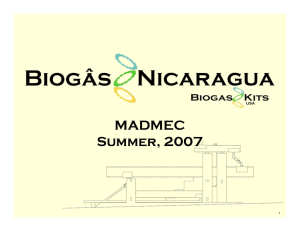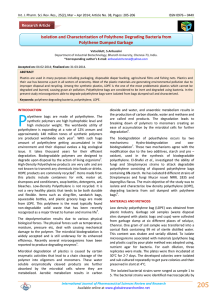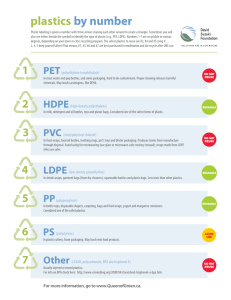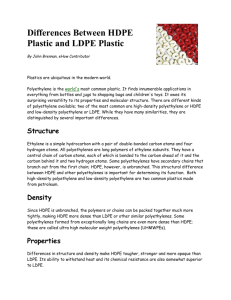Document 14111283
advertisement
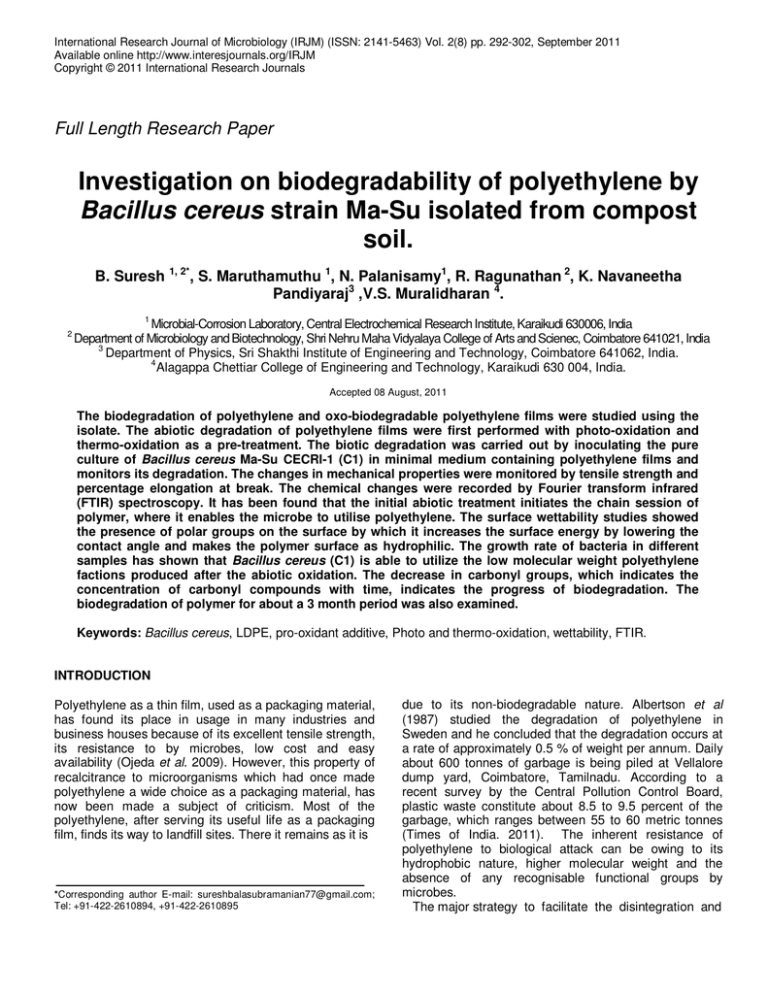
International Research Journal of Microbiology (IRJM) (ISSN: 2141-5463) Vol. 2(8) pp. 292-302, September 2011 Available online http://www.interesjournals.org/IRJM Copyright © 2011 International Research Journals Full Length Research Paper Investigation on biodegradability of polyethylene by Bacillus cereus strain Ma-Su isolated from compost soil. B. Suresh 1, 2*, S. Maruthamuthu 1, N. Palanisamy1, R. Ragunathan 2, K. Navaneetha Pandiyaraj3 ,V.S. Muralidharan 4. 1 2 Microbial-Corrosion Laboratory, Central Electrochemical Research Institute, Karaikudi 630006, India Department of Microbiology and Biotechnology, Shri Nehru Maha Vidyalaya College of Arts and Scienec, Coimbatore 641021, India 3 Department of Physics, Sri Shakthi Institute of Engineering and Technology, Coimbatore 641062, India. 4 Alagappa Chettiar College of Engineering and Technology, Karaikudi 630 004, India. Accepted 08 August, 2011 The biodegradation of polyethylene and oxo-biodegradable polyethylene films were studied using the isolate. The abiotic degradation of polyethylene films were first performed with photo-oxidation and thermo-oxidation as a pre-treatment. The biotic degradation was carried out by inoculating the pure culture of Bacillus cereus Ma-Su CECRI-1 (C1) in minimal medium containing polyethylene films and monitors its degradation. The changes in mechanical properties were monitored by tensile strength and percentage elongation at break. The chemical changes were recorded by Fourier transform infrared (FTIR) spectroscopy. It has been found that the initial abiotic treatment initiates the chain session of polymer, where it enables the microbe to utilise polyethylene. The surface wettability studies showed the presence of polar groups on the surface by which it increases the surface energy by lowering the contact angle and makes the polymer surface as hydrophilic. The growth rate of bacteria in different samples has shown that Bacillus cereus (C1) is able to utilize the low molecular weight polyethylene factions produced after the abiotic oxidation. The decrease in carbonyl groups, which indicates the concentration of carbonyl compounds with time, indicates the progress of biodegradation. The biodegradation of polymer for about a 3 month period was also examined. Keywords: Bacillus cereus, LDPE, pro-oxidant additive, Photo and thermo-oxidation, wettability, FTIR. INTRODUCTION Polyethylene as a thin film, used as a packaging material, has found its place in usage in many industries and business houses because of its excellent tensile strength, its resistance to by microbes, low cost and easy availability (Ojeda et al. 2009). However, this property of recalcitrance to microorganisms which had once made polyethylene a wide choice as a packaging material, has now been made a subject of criticism. Most of the polyethylene, after serving its useful life as a packaging film, finds its way to landfill sites. There it remains as it is *Corresponding author E-mail: sureshbalasubramanian77@gmail.com; Tel: +91-422-2610894, +91-422-2610895 due to its non-biodegradable nature. Albertson et al (1987) studied the degradation of polyethylene in Sweden and he concluded that the degradation occurs at a rate of approximately 0.5 % of weight per annum. Daily about 600 tonnes of garbage is being piled at Vellalore dump yard, Coimbatore, Tamilnadu. According to a recent survey by the Central Pollution Control Board, plastic waste constitute about 8.5 to 9.5 percent of the garbage, which ranges between 55 to 60 metric tonnes (Times of India. 2011). The inherent resistance of polyethylene to biological attack can be owing to its hydrophobic nature, higher molecular weight and the absence of any recognisable functional groups by microbes. The major strategy to facilitate the disintegration and Suresh et al. 293 Table 1. Component characteristics of LDPE blown film samples used in biodegradation tests Sample Code Film thickness (µm) Oxo-biodegeradable Additive (%) Polyethylene (%) LDPE BPE10 50±01 50±01 10 100 090 subsequent degradation of the polymeric polyethylene chain is focused on direct incorporation of carbonyl groups within the backbone or in situ generation by introduction of pro-oxidant at the processing stage. Many of the commercially available oxo-biodegradable additives help the degradation of the polyethylene in the presence of sunlight. The oxo-biodegradable additives contain specific transition metals (Mn, Fe and Co) as prooxidant. These compounds act as catalysts in speeding up the normal reactions of oxidative degradation with the overall reaction rate increased by several orders of magnitude. The products of the catalyzed oxidative degradation of plastics are precisely the same as for conventional plastics because other than the small amount of additive present, the plastics are indeed conventional plastics The disposal by degradation of these polymeric wastes to harmless and useful compounds is a challenging task to combat pollution. The extent of degradation of polymers depends on the nature of chemical process involved. The degradation process may be carried out by photochemical, thermal and biodegradation process. Out of these, biodegradation is much simpler, economic and occurs in normal conditions of waste disposal without any extra pre-requisites. The main attacking microorganisms like bacteria, actinomycetes, fungi, etc., which are wide spread in the soil. Crabbe et al, (1994) reported the polyurethane degrading soil fungi including Fusarium solani, Curvularia senegalensis, Aureobasidium pillulans and Cladosporidium sp. A number of bacteria were also claimed to degrade polyurethane namely, Acinetobacter calcoaceticus, Arthrobacter globiformis, Pseudomonas aeruginosa, Pseudomonas cepacia and Pseudomonas putida (El-Sayed et al. 1996). This study aims to isolate and identify the low density polyethylene degrading bacterium from the Municipal compost yard Vellalore, Coimbatore, Tamilnadu. The isolated polyethylene degrading microorganisms were identified by standard physiological and biochemical tests and 16S rRNA gene sequence analysis. In pure culture with the isolate, the in vitro polyethylene degradation was observed for initial 3 months and reported. Here the polymer is supplied to the organism as a sole source of carbon. The changes in its physical, chemical and mechanical properties at different time intervals were monitored. MATERIALS AND METHODS Polyethylene Commercial grade low density polyethylene (24FSO40) was used for the preparation of polyethylene films. The MFI for the polymer was 1. The oxo-biodegradable additive supplied from KK Polycolor India Ltd, was incorporated in 10% loading with the Pristine LDPE, to prepare 10% modified LDPE films. Preparation of low density polyethylene film Thin films (50±01µm) were prepared by mixing varying amounts of (10 and 20 %) of oxo-biodegradable additive with LDPE in a film blowing machine using an extruder (Gurusharan Polymer Make) with a 40 mm screw of L:D :: 26:1 attached to a film blowing die. A spiral die with a dia of 4 inch and a die gap of 0.5 mm was employed for this purpose. Films of uniform thickness were prepared by maintaining a constant nip roller; take up the speed of 35 rpm under constant blowing. The temperature in barrel zones were maintained at 125 °C (feed zone), 135°C (compression zone) and that of the die section was 150°C (die zone). The films were prepared as lay flat tube of bubble size 150mm dia. Pristine LDPE films were designated as LDPE and films containing oxo-biodegradable additive were designated as BPE followed by a numerical suffix indicating the amount of additive added. LDPE films containing 10% oxo-biodegradable additive were designated as BPE10 as shown in Table 1. Abiotic treatment: Photodegradation Thermooxidation procedure and Fifty micrometer thick blown film of LDPE and BPE 10 were irradiated with 40 W UV-B lamps generating energy between 280 and 370 nm with a maxima at 313 nm in air at room temperature (30±1 °C) on open racks positioned 5 cm from the lamp (Roy et al., 2006). Exposures were conducted uninterrupted, 24h per day and the samples recovered in 21 days. The samples were aging thermally oxidised in a hot air oven for 10 days at 70°C (Nils et al., 294 Int. Res. J. Microbiol. Table 2. Physiological and biochemical characteristics of municipal compost yard soil isolate B.cereus (C1). Characteristics Shape Gram’s Reaction Motility Indole production Oxidase Catalase Starch hydrolysis Gelatin hydrolysis Sugar fermentation Glucose Lactose Nitrate reduction C1 isolate Bacillum Gram positive + _ _ + + + + + +, Positive; -, Negative 2009). Isolation of Bacterial strain Soil samples were collected from different locations in Municipal compost yard Vellalore, Coimbatore, Tamilnadu and used for the isolation of naturally occurring Bacterial strains. One gram of soil was suspended to 100 ml of medium A ( 0.1 g polyethylene, 0.3g of NH4NO3, 0.5g of K2HPO4, 0.1g of NaCl, 0.02g of MgSO4.7H2O, 0.01 g of yeast extract, 10 µg of thiamine. HCl, 20 µg of riboflavin, 20 µg of nicotinic acid, 20 µg of Ca-pantothenate, 20 µg of pyridoxine-HCl, 1 µg of biotin, 10 µg of p-aminobenzoic acid, 1 µg of folic acid and distilled water; pH 7±0.2 [Roy et al., 2008]. The shaking was carried out in 120 rpm for 100 ml medium in 500 ml shaking flask. The cultures were incubated and kept shaking for 1 month. Then 1 ml of the suspension was put into 4 ml of fresh medium. After 1 week of shaking, 5 µl of the culture was spread on a 2% agar plate of medium A and the plates were incubated at 37°C for few days. The colonies were preserved at 4°C in 2% agar slants of medium B ( 5% malt extract, 0.3% yeast extract and distilled water; pH 7±0.2 ) (Onoddera et al., 2001). Medium and conditions for cultivation of bacteria The mineral medium-C utilized for the growth of bacteria contained (g-1), NH4Cl 1.0; K2HPO4 1.0; KH2PO4 0.5; NaCl 30; MgSO4.7H2O 0.5; CaCl2.2H2O 0.2; KCl 0.3; FeCl2 0.01; and 1 ml of trace element solution [prepared by adding the following in g-1 of distilled water: FeCl2 1.5; H3BO3 0.006; MnCl2 0.1; CoCl2 0.19; ZnCl2 0.07; NiCl2 0.024; CuCl2 0.002: Na2MoO4 0.036 and HCl (25%)] 100 ml. The pH of the medium was adjusted to 7.5 with 1N NaOH and was sterilized by autoclaving for 15 min, 15 lbs at 121°C. The inoculums consisted of 3% (V/V) 24 h old bacterial culture grown in the broth medium B [Roy et al., 2008]. The flasks containing the bacterial culture were maintained at 37°C with continuous shaking in a rotary incubatory shaker (120 rpm). Pre-treated / Untreated polyethylene films (10 cm X 2.5 cm) were first washed with ethanol, rinsed in sterile distilled water and subsequently dried till getting constant weight and exposed to this bacterial culture medium. The films were recovered in regular intervals for monitoring the changes brought about by bacterial action. A set of controlled experiments were performed in flasks containing the pretreated polyethylene films in basal medium devoid of bacterial culture (Roy et al., 2008). All the reactions were run simultaneously in triplicate. Identification and characterisation of the isolated organism The biochemical characterization of bacterial isolates (Table.2) was done based on Bergey’s Manual of Determinative Bacteriology (Holt et al., 1994). The genomic DNA was isolated by spinning 1.5 ml of the culture in a refrigerated micro centrifuge (REMI ELEKTROTECHNIK LIMITED, Mumbai, India) at 10,000 rpm for 2 min. Resuspend the pellet in 567 µl TE buffer, add 30 µl of 10% SDS and 3 µl. of 20 mg/ml proteinase K to a final concentration of 100 µg/ml proteinase K in 0.5% SDS. Mix thoroughly and incubate for 1 hr. Add 100 µl. of Suresh et al. 295 5 M NaCl and 80 µl. of CTAB/NaCl solution. Incubate 10 min at 65°C and add an equal volume (0.7 to 0.8 ml) of Phenol/Chloroform/Isoamyl-alcohol, mix thoroughly, and spin 4 to 5 min. Remove aqueous, viscous supematant. Add an equal volume of chloroform/isoamyl alcohol, extract, and spin in a microcentrifuge at 10,000 rpm for 5 min. Transfer the supernatant to a fresh tube. Add 0.6 vol. isopropanol to precipitate the nucleic acids. Wash the DNA with 70% ethanol to remove residual CTAB and respin 5 min at room temperature to repellet it. Dissolve the pellet in 100 µl TE buffer (Sambrook and Russel. 2006). Polymerase chain reaction (PCR) was performed with a final volume of 10 µl in 0.2 ml thin-walled tubes. The primers used for PCR amplification of the 16S rRNA gene were: 16s forward primer 5'AGAGTRTGATCMTYGCTWAC-3' and 16s reverse prime 5'-CGYTAMCTTWTTACGRCT-3' (Sigma Genosys). Each reaction mixture contained 1 µl of template DNA (100 ng / µl ), 2 µM of two primers, 3 µl of Milli Q water and 4 µl of Big dye Terminator Ready Reaction Mix . The PCR programme consisted of an initial denaturation step at 96°C for 1 min, followed by 35 cycles of DNA denaturation at 96°C for 10 s, primer annealing at 50°C for 0.5 min, and primer extension at 60°C for 4 min carried out in thermal cycler (TECHNE, TC-512, USA). After the last cycle, a final extension at 72°C for 20 min was performed. The PCR product was sequenced using an automated sequencer (ABI 3130 Genetic Analyzer). The Seq Scape_ v 5.2 software package, was used to obtain the consensus sequence. Sequences of closely related type strains used for constructing the phylogenetic tree were selected and retrieved from the NCBI databases by BLAST searches for bacteria. Alignment was performed with CLUSTAL X (version 1.8w) (Thompson et al. 1997) and evolutionary distances and Knuc values (Kimura. 1980) were generated. BioEdit software (Hall. 1999) was used to remove gaps and ambiguous bases in the alignments. A phylogenetic tree was constructed from 1429 unambiguously aligned nucleotides using the neighbour-joining method (Saitou et al., 1987) contained in the PHYLIP software package (Felsenstein. 2005) and plotted with NJ Plot software. The stability and reproducibility of the relationship was assessed by bootstrap analysis (Felsenstein. 2005). Measurement of biological parameters Total cellular protein 1 ml suspension was centrifuged at 7000 rpm for 10 minutes. The cell pellets were washed with normal saline solution. The cells were then suspended in 1N NaOH and boiled for 10 minutes to disrupt the cells. It was centrifuged to remove cell debris. The supernatant fluid was assayed for protein by Lowry’s method (Lowry et al., 1951). Physio chemical measurements The physical, chemical and mechanical changes that had taken place due to biodegradation of the PE film were monitored as described below. Four types of polyethylene samples were analysed; (i) Pre-treated LDPE without B.cereus (C1) [control], (ii) Pretreated LDPE with B.cereus (C1), (iii) Pre-treated BPE 10 with B.cereus (C1) and (iv) Untreated LDPE with B.cereus (C1). Mechanical strength test Changes in mechanical properties like tensile strength and elongation at break were performed on LDPE films according to ASTM 882-85 using INSTRON machine (no. 6021). Films of 100 mm length and 25 mm width were made as strips and subjected to a crosshead speed of 100 mm/min. The tests were taken at air-conditioned environment at 21°C and with a relative humidity of 65 %. The value is the average of five samples for each experiment. Fourier transformed infrared spectroscopy (FT-IR) The surface chemical modifications which occur in LDPE films upon thermo-oxidation were investigated using FTIR spectroscopy. The FTIR spectra were recorded using a Thermo Nicolet, Avatar 370 spectrophotometer in the spectral range between 4000-400 cm -1. Contact angle and surface energy Wettability determinations of film surfaces submitted to thermo-oxidation were performed by contact angle measurements on samples using a video based contact angle meter OCA 20 attached to a camera. The wetting liquid used was Millipore grade distilled water (liquid surface tension ( ) = 72.8 mJ/m2). The value is the average of five samples for each experiment. Surface energy was calculated using equation of state, Schultz Method-2, using Data Physics SCA20 software (Version 2.01). Morphological analysis Changes in the surface morphology due to biodegradation were investigated with SEM, (JEOL Model JSM - 6390LV) using a voltage of 15kv. 296 Int. Res. J. Microbiol. Figure 1. 16S rRNA gene sequence-based dendrogram showing the phylogenetic position of municipal compost yard soil isolate Bacillus cereus [C1] along with sequences available in the GenBank database. Photomicrographs were taken at uniform magnification of 5000 fold. 16S rRNA gene sequence of strain C1 has been designated Bacillus cereus Ma-Su CECRI-1 strain and deposited in the GenBank database under Accession No. GQ 501070. RESULTS Isolation, bacteria identification and characterization of To isolate polyethylene degrading bacteria the sail samples were plated in mineral medium-C. Before plating in medium C, the soil samples were enriched with medium A, containing polyethylene as a sole source of carbon for the period of one month. We screened more than 50 bacterial strains. Among them only two bacterial strains (C1 and C2) showed strong activity on polyethylene and were isolated in minimal medium A, the experiments were performed initially with C1 isolate. The C1 isolate was Gram positive bacillum with colonies of large, irregular and flat with an undulate margin in agar plate. The C1 was motile, produce indole and hydrolyse starch and gelatine. It fermented glucose but unable to utilise lactose .Isolate C1 was characterized as B. cereus based on its physiological and biochemical characteristics and a 16S rRNA sequence analysis. The nucleotide BLAST analyses among the neighbouring similar organisms showed that C1 isolate belongs to phylum Firmicutes and family Bacillaceae. Phylogenetic analysis revealed that C1 showed 98% similarity with species of Bacillus (Figure 1.). A similar search among the close neighbours of Bacillus spp. using BLAST at the NCBI revealed a high similarity with B. cereus strain. The Pre-treatment initiated abiotic degradation The abiotic pre-treatment involved the exposure of LDPE films to UV-B radiation for total of 21 days and thermal oxidation for 10 days. After this period, pristine LDPE and LDPE with pro-oxidants undergoing the light and heat treatment, the polymer is chemically modified and is more susceptible for microbial attack [Bonhomme et al., 2003]. The catalytic degradation in the presence of transition metal in polyethylene has been attributed to its ability to generate free radicals on the surface of polyethylene, which later react with oxygen to generate carbonyl groups (Osawa et al., 1979; Osawa 1988). Microbial growth on polymer containing medium The growth of bacteria as a function of biotic exposure time is presented in Figure 2. It has been suggested that carbon limitation may facilitate the slow growth on polyethylene films such as lignin (Iioshi et al.,1998). Among the polyethylene films, pre-treated BPE10 enhances the growth of B.cereus (C1) compared with the untreated LDPE sample. The culture flask containing BPE 10 inoculated with Bacillus cereus (C1) showed 28 3 X 10 CFU/ml after 90 days of incubation. Where as the Suresh et al. 297 Figure 2. CFU counts for various LDPE samples treated with Bacillus cereus (C1) Table 3. Total cellular protein content of untreated / pre-treated LDPE and BPE 10 films exposed to B.cereus (C1) with period of incubation. Time (Days) 0 15 30 45 60 75 90 Total cellular protein (µg/ml) Pre-treated Pre-treated Un-treated LDPE BPE 10 LDPE 123 128 119 134 137 124 152 165 140 213 242 153 324 351 161 369 423 148 412 509 256 pre-treated LDPE flask sample showed 17 X 103 CFU/ml after 90 days of incubation. At the same time the growth of organism was very poor in untreated LDPE sample containing medium. The pre-treated LDPE uninoculated act as control and all the flasks were monitored for contamination at regular time intervals by plating technique. Total cellular protein Total cellular protein (Table.3.) was found to increase up to 90 days, which reflects increase in biomass after which the growth was found normal. This indicates that extracellular enzymes are involved in the polymer biodegradation. The pre-treated BPE 10 provides excellent nutrient to B.cereus (C1) and showed the total cellular protein content of 509 µg/ml. FTIR studies Figure 3. shows FT-IR spectra obtained by the films of four different LDPE samples. It was found that some new peaks arose after the period of biodegradation. They can be assigned to specific peaks, such as dehydrated dimer -1 of carbonyl group (1720 cm ), CH3 deformation (1463 -1 cm ) and C=C conjugation band (862 cm-1). In figure 3(a). shows the increase in carbonyl peak (1720 cm-1 ) as the increase in incubation period of pre-treated LDPE with B.cereus (C1). The FTIR spectra of pre-treated BPE10 in Figure 3(b) shows, the introduction of ketocarbonyl functional group (1718 cm -1) after 1 month of biodegradation and the intensity increases with irradiation period up to 3 months and at the same time a broadening of the band which indicates the presence of more than one oxidation product [Sudesh et al, 2007]. In pre-treated LDPE without B.cereus (C1), the carbonyl bond is a 298 Int. Res. J. Microbiol. 3 Month Incubation 3 Month incubation 1718 % Transmittance % Transmittance 1721 0 Month Incubation 1720 0 Month incubation (a) 500 1000 1500 2000 2500 3000 (b) 3500 500 1000 1500 -1 2000 2500 3000 3500 -1 Wave number (cm ) Wavenumber (cm ) 3 Month Incubation 180 3 Month Incubation 160 % Transmittance % Transmittance 140 0 Month Incubation 120 100 80 0 Month Incubation 60 40 20 (c) 500 1000 1500 2000 2500 3000 3500 -1 Wave number (cm ) (d) 0 1000 1500 2000 2500 3000 3500 -1 Wave number (cm ) Figure 3. FTIR spectra of UV-Thermal pre-treated and untreated LDPE samples (a) Pretreated LDPE exposed to B.cereus (C1), (b) Pre-treated BPE 10 exposed to B.cereus (C1), (c) Pre-treated LDPE unexposed to B.cereus (C1) and (d) Un-treated LDPE exposed to B.cereus (C1) result of overlapping of various stretching vibration bands including those of aldehydes and/or esters and carboxylic acid groups in figure 3(c). There was not any marked change noted after a month till 3 months. In spectra figure 3(d) shows a slow decrease in peak 2662 cm-1 and 2926 cm-1, due to reduced rate of bacterial utilization. Contact angle and surface energy measurements The extent of hydrophilic modification of Untreated / UV irradiated and thermally oxidised LDPE and BPE 10 samples were investigated by contact angle measurement. Figure 4, shows the variation in the contact angle of the four different samples at different time intervals. The contact angle of Untreated LDPE incubated with isolate C1 shows an initial of 102.08° and in progress of 3 months the value slightly reduced to 99.91°. The sample pre-treated LDPE uninoculated shows the variation form 96.14° at 0 month to 92.98° at 3 months of incubation. The reduction without microbial inoculum was attributed to the pre-treatment and the temperature influenced by incubator. The pre-treated LDPE incubated with isolate C1 showed a decrease from 96.14° to 86.08°, the bacterium finds to utilize the pre- treated polymer as its intact cross links have been broken down by chain session. The BPE 10 shows more aggressive reduction in contact angle from 97.72° to 80.32°. As it was incorporated pro-oxidants, naturally the abiotic pre-treatment initiates the free radicals. The free radical formed on polyolefin reacts with oxygen to form peroxy radical, which can abstract a proton from some other labile positions, thereby forming hydroperoxides and a new radical site. They introduce the functional groups and substances capable to promote the formation of free radical precursor moieties (e.g. hydroperoxides) by photo physical and thermal decomposition in order to induce cleavage of macromolecular polymer chain which makes easy to degrade the polyethylene by the microbe. Figure 5, Illustrates the variation in surface energy of four samples as a function of incubation time. The surface energy of untreated LDPE, pre-treated LDPE, pre-treated BPE10 incubated with B.cereus (C1) and uninoculated 2 2 pre-treated LDPE films were 21.78 mJ/m , 25.41 mJ/m , 2 2 24.44 mJ/m and 25.41 mJ/m respectively. After 3 months of biodegradation the surface energy increased with respect to time. Untreated LDPE, pre-treated LDPE, pre-treated BPE10 incubated with B.cereus (C1) and uninoculated pre-treated LDPE film sample showed the 2 2 increased surface energy of 22.98 mJ/m , 32.52 mJ/m , Suresh et al. 299 120 Pre treated LDPE Uninoculated Pre treated LDPE with inoculum Pre treated BPE10 with inoculum Untreated LDPE with inoculum 115 Contact angle (Degree) 110 105 100 95 90 85 80 0.0 0.5 1.0 1.5 2.0 2.5 3.0 Months Figure 4. Variation in contact angle of untreated / pre-treated LDPE and BPE 10 films with and without inocula as a function of exposure time 36 Pre treated LDPE Uninoculated Pre treated LDPE with inoculum Pre treated BPE10 with inoculum Untreated LDPE with inoculum 35 34 Surface Energy (mN/m) 33 32 31 30 29 28 27 26 25 24 23 22 21 0.0 0.5 1.0 1.5 2.0 2.5 3.0 Months Figure 5. Surface energy variation profile of untreated / pre-treated LDPE and BPE 10 films exposed and unexposed to B.cereus (C1) as a function of exposure time 2 2 35.33 mJ/m and 27.28 mJ/m respectively. Mechanical properties After 3 months of exposure to biodegradation with B.cereus (C1) the tensile strength of untreated LDPE, pre-treated LDPE, pre-treated BPE10 incubated with B.cereus (C1) and uninoculated pre-treated LDPE films were reduced to 15.14 MPa, 17.10 MPa, 13.89 MPa and 14.11 MPa from initial values of 16.57 MPa, 14.13 MPa, 13.11 MPa and 14.13 MPa respectively as shown in figure 6. The increase of tensile strength in pre-treated LDPE may be attributed to chain cross linking during photo-oxidation (Qureshi et al., 1990). Figure 7, reveals the elongation at break for all the four samples. The pre-treated LDPE retains the percentage of elongation and on the other hand the pre-treated BPE 10 300 Int. Res. J. Microbiol. 24 Pre treated LDPE Uninoculated Pre treated LDPE with inoculum Pre treated BPE10 with inoculum Untreated LDPE with inoculum 22 Tensile strength (MPh) 20 18 16 14 12 10 8 6 4 2 0 0 1 2 3 Period of incubation (Month) Figure 6. Variation in tensile strength of untreated / pre-treated LDPE and BPE 10 films exposed and unexposed to B.cereus (C1) with period of incubation. 1100 Pre treated LDPE Uninoculated Pre treated LDPE with inoculum Pre treated BPE10 with inoculum Untreated LDPE with inoculum 1000 Elongation at break (%) 900 800 700 600 500 400 300 200 100 0 -0.5 0.0 0.5 1.0 1.5 2.0 2.5 3.0 3.5 Period of incubation (Month) Figure 7. Percentage elongation of untreated / pre-treated LDPE and BPE 10 films exposed and unexposed to B.cereus (C1) with period of incubation. 10 shows fluctuation. Surface Morphological studies The surface morphology of LDPE films were investigated using scanning electron microscope. The SEM micrographs (Figure 8) indicate the bacterial adhesion and biofilm formation on the polymer surface films exposed to biotic environment. The pre-treated LDPE and BPE 10 inoculated with B.cereus (C1) shows the evidence of microbial growth on the film surfaces (the untreated LDPE incubated with culture C1 and the pre- treated LDPE without microbial inoculum C1 were not shown in the micrograph as they do not show any significance). The biological attack of polymer generally begins with the colonization of bacteria on polymer film surfaces. The adhesion was scattered, not uniform, indicating that the amorphous region of the polymer was more susceptible to microbial adhesion and degradation DISCUSSION The pre-treatment with UV and thermal oxidation before incubation has increased the biodegradation by Suresh et al. 301 Figure 8. SEM micrographs showing the growth of B.cereus (C1) on surface of (a) pre-treated LDPE and (b) pre-treated BPE10 facilitating the bacterial growth by 61% in pre-treated BPE 10 than the pre-treated LDPE. This is because the bacterium was capable of utilizing the polyethylene, especially the oxygenated fragments as their sole source of carbon. It has also been reported that the microorganisms produce necessary oxidative and degradative enzymes for degrading and assimilating the polymeric carbon into their biomass and thus divide and grow in number (Seneviratene et al., 2006; Haded 2005). The microbe initially acclimatizes to the carbon limited medium and then starts utilizing the polyethylene. Hence the initial carbonyl and keto peaks slowly reduce as the incubation period progresses. As the sample was untreated the microbial colonization takes time to initiate the biodegradation of LDPE. Sudhaker et al (2008), reported the bacterium isolated from marine, B.cereus is more efficient than B.sphericus in degrading LDPE and HDPE. Previous study reports that Bacillus sp. is capable of producing extracellular enzymes such as oxidoreductase could be one of the key factors for the biodegradation of pre-treated LDPE and BPE 10 effectively in this present study. The increase in surface energy and decrease in contact angle indicates the polymer turns to more hydrophilic, thus facilitating the bacterial attachment on the surface of polymer. The decrease in mechanical strength of the additive added polymer after 3 months of incubation with B.cereus (C1) was due to the initial absorption of energy in the form of light and the pro-oxidant catalyses the chain session by forming free radicals and thereby facilitating the microbe to degrade the polymer back bone (Albertsson et al., 1987; Saucedo et al., 2008). The pro-oxidant additive played a vital role in accelerating the polymer chain session during photo and thermal oxidation, thereby the samples BPE10 lose their property of elongation at break gradually followed by microbial degradation (Chiellini et al. 2006).It has been reported earlier that the microbial growth is mainly concentrated around the fissures, which suggests that the low molecular nutrients migrate to the surface from the bulk of the polymer (Haded 2005; Roy et al., 2008). In conclusion the present study reveals that potential isolate of Bacillus cereus (C1) from the municipal compost yard soil capable of degrading low density polyethylene. The strain exhibits the ability to utilize polyethylene as a carbon source. The introduction trace quantities of pro-oxidants initiate the abiotic degradation of polyethylene film in BPE 10. The pre-treatment with UV and thermal oxidation of polyethylene films were capable of supporting the microbial growth. The abiotic phase leads to modify the carbon backbone and chain session simultaneously. The oxygenated compounds and the low molecular weight hydrocarbons formed as a result of abiotic treatment are recognised by the bacterial strain (Bacillus cereus (C1), which is capable of utilizing it and grow in number. The decrease in carbonyl group is due to biodegradation of polyethylene through Norrish (biotic) type mechanism (Sudhaker et al., 2007). As a result of bioerosion, the film exhibits (i) decrease in tensile strength, elongation at break and contact angle;(ii) introduction of new polar groups such as –OH, C=O, COOH and COO- on the main chain of the polymer matrix and (iii) the bacterial attachment is clearly visible in SEM micrographs. Thus the new bacterial isolate Bacillus cereus Ma-Su CECRI-1 (C1) shows the potential of polyethylene biodegradation. The pro-oxidant added polyethylene seems to be highly susceptible for the isolate Bacillus cereus Ma-Su CECRI-1 (C1) attack as the pro-oxidants initiates the abiotic degradation process and makes the low molecular weight polyethylene available for microbial assimilation. These kinds of bacterial isolates and modified polyethylene will be helpful in the biodegradation of polyolefins in the near feature to overcome the plastic litter pollution. The 302 Int. Res. J. Microbiol. decrease in contact angle showed the formation of hydrophilic groups in irradiated LDPE and BPE film surfaces. On absorption of energy in the form of light, the components present in the pro-oxidant additive forms free radicals. These species can combine with oxygen from air, that generates the introduction of polar groups such as –OH, C=O, COOH and COO- on the main chain of the polymer matrix. The presences of these groups were confirmed through FT-IR spectra. It leads to chain session in LDPE which alters the hydrophobic nature of the surface (Bikaris et al., 1997). This phenomenon was relatively slower in PE films without pro-oxidant additive. ACKNOWLEDGEMENTS The authors wish to express their thanks to The Director, CECRI, Karaikudi for his kind permission. We are immensely thankful to M/S Sri Lakshmi Narayana Plastics, Coimbatore for providing the virgin polyethylene and blended polyethylene films and for their helpful discussions. Appreciation is also extended to Sophisticated Test and Instrumentation Centre (STIC), Cochin University of Science and Technology, Cochin, Kerala for providing analytical support. We also express our sincere thanks to Central Instrumentation Facility (TEQIP), Birla Institute of Technology,Ranchi REFERENCES Albertsson AC, Andersson, SO, Karlsson S (1987). The mechanisms of biodegradation of polyethylene. Polym Degrad Stab. 18(1): 73–87. Bikaris D, Prinos J, Perrier C, Panayiotou C (1997). Thermo analytical study on the effect of EAA and starch on the thermooxidative degradation of LDPE. Polym. Degrad. Stab. 57: 313-324. Bonhomme S, Cuer A, Delort AM, Lemaire J, Sancelme M, Scott G (2003). Environmental biodegradation of polyethylene. Polym. Degrad. Stab. 81: 441-452. Chiellini E, Corti A, Antone SD, Baciu R (2006). Oxo-biodegradable carbon backbone polymers – Oxidative degradation of polyethylene under accelerated test conditions. Polym. Degrad. Stab. 91: 27392747. Crabbe JR, Campbell JR, Thompson L, Walz SL, Scultz WW (1994). Biodegradation of colloidal ester based polyurethane by soil fungi. Int. Biodeterior. Biodegrad 33: 103 – 113. El-Sayed AHMM, Mohmoud WM, Davis EM, Coughlin RW (1996). Biodegradation of polyurethane coatings by hydro-carbon degrading bacteria. Int. Biodeterior. Biodegrad 37: 69-79. Felsenstein J (2005). PHYLIP (Phylogeny Inference Package) version 3.6. Distributed by the author. Department of Genome Sciences, University of Washington, Seattle, USA. Haded D (2005). Biodegradation of polyethylene by thermophillic bacterium Brevibacillus borstelensis. J. Appl. Microbiol. 98: 10931100. Hall TA (1999). BioEdit: a user-friendly biological sequence alignment editor and analysis program for Windows 95/98/NT. Nucleic Acids Symp. Ser 41: 95–98. Holt JG, Kreig NR, Sneath PHA, Stanely JT (1994). In Bergey’s Manual of Determinative Bacteriology (ed. Williams, S. T.), Williams and Wilkins, Maryland. Iioshi Y, Tsutsumi Y, Nishida T (1998). Polyethylene degradation by lignin-degrading fungi and manganese peroxidise. J. wood sci., 44: 222-229. Joseph Sambrook, David W, Russel (2006).The condensed protocols. From molecular cloning; A laboratory manual. Cold Spring Harbor, New York. Keiko Yamada-Onoddera, Hiroshi Mukumoto, Yuhji Katsuyaya, Atsushi Saiganji, Yoshiki Tani (2001) Degradation of polyethylene by a fungus Penicillium simplicissimum YK. Polym. Degrad. Stab.72: 323327. Kimura M (1980).A simple method for estimating evolutionary rates of base substitutions through comparative studies of nucleotide sequences. J. Mol. Evol. 16: 111–120. Lowry DH, Russenbrough NJ, Farr AL, Randall RJ (1951) J. Biol. Chem. 193: 265. Nils B, Vogt, Emil Arne Kleppe (2009). Oxo-biodegradable polyolefins show continued and increased thermal oxidative degradation after exposure to light. Polym. Degred. Stab. 94: 659-663. Osawa Z (1988). Role of metals and metal deactivators in polymer degradation. Polym. Degrad. Stab. 20: 203-236. Osawa Z, Kurisu N, Nagashima K, Nankano K (1979).The effect of transition metal stearate on the photodegradation of polyethylene. J. Appl. Polym. Sci. 23: 3583-3590. Qureshi FS, Amin MB, Maadhah AG, Hamid SH (1990). Weather induced degradation of linear low density polyethylene: mechanical properties. J. polym Eng. 9: 67-84. Roy PK, Surekha P, Rajagopal C, Raman R, Choudhary V ( 2006). Study on the degradation of LDPE in presence of cobalt stearate and benzyl. J Appl Polym Sci. 99: 236-243. Roy PK, Titus S, Surekha P, Tulsi E, Deshmukh C, Rajagopal C (2008). Degradation of abiotically aged LDPE films containing prooxidant by bacterial consortium. Polym. Degred. Stab. 93: 19171922. Saitou N, Nei M (1987) The neighbor-joining method: a new method for reconstructing phylogenetic trees. Mol. Biol. Evol. 4: 406–425. Saucedo J-E, Lucas N, Belloy C, Queneudec M, Silvestre F (2008) Polymer Biodegradation: Mechanisms and estimation techniques. Chemosphere. 73: 429-442. Seneviratene G, Tennakoon NS, Weerasekara ML, Nandasena KA (2006) Polyethylene biodegradation by a developed PenicilliumBacillus biofilm. Curr. Sci.90: 20-21. Sudesh S, Fernando, Paul A, Christensen, Terry A, Egerton Jim, R White (2007). Carbon dioxide evolution and carbonyl group development during photodegradation of polyethylene and polypropylene. Polym Degrad Stab. 92: 2163-2172. Sudhakar M, Mukesh Dobel, Sriyutha Murthy, Venkatesan R (2008). Merine microbe-mediated biodegradation of low-and high – density polyethylenes. Int. Biodeterior. Biodegrad. 61: 203-213. Sudhaker M, Trishul A, Mukesh Doble, Suresh Kumar K, Syed Jahan S, Inbakandan D, Viduthalai RR, Umadevi VR, Sriyutha Murthy P, Venkatesan R (2007). Biofouling and biodegradation of polyolefins in ocean waters. Polym. Degrad. Stab. 92: 1743 – 1752. Sunday Times of India (2011) Coimbatore Ed, India. Apr 10:P 3. Telmo FM Ojeda, Emilene Dalmolin, Maria MC Forte, Rodrigo JS Jacques, Fatima M Bento, Flavio AO camargo (2009). Abiotic and biotic degradation of oxo-biodegradable polyethylenes. Polym. Degrad. Stab. Doi: 10.1016/j.polymdegradstab.03.011. Thompson JD, Gibson TJ, Plewniak F, Jeanmougin F, Higgins DG (1997). The CLUSTAL_X windows interface: flexible strategies for multiple sequence alignment aided by quality analysis tools. Nucleic Acids Res 25: 4876–4882.

